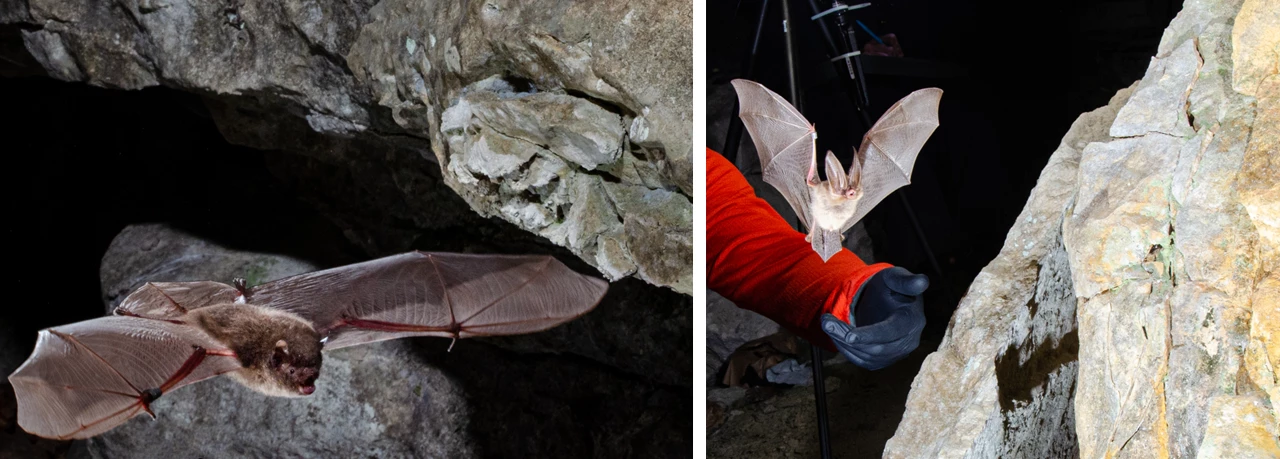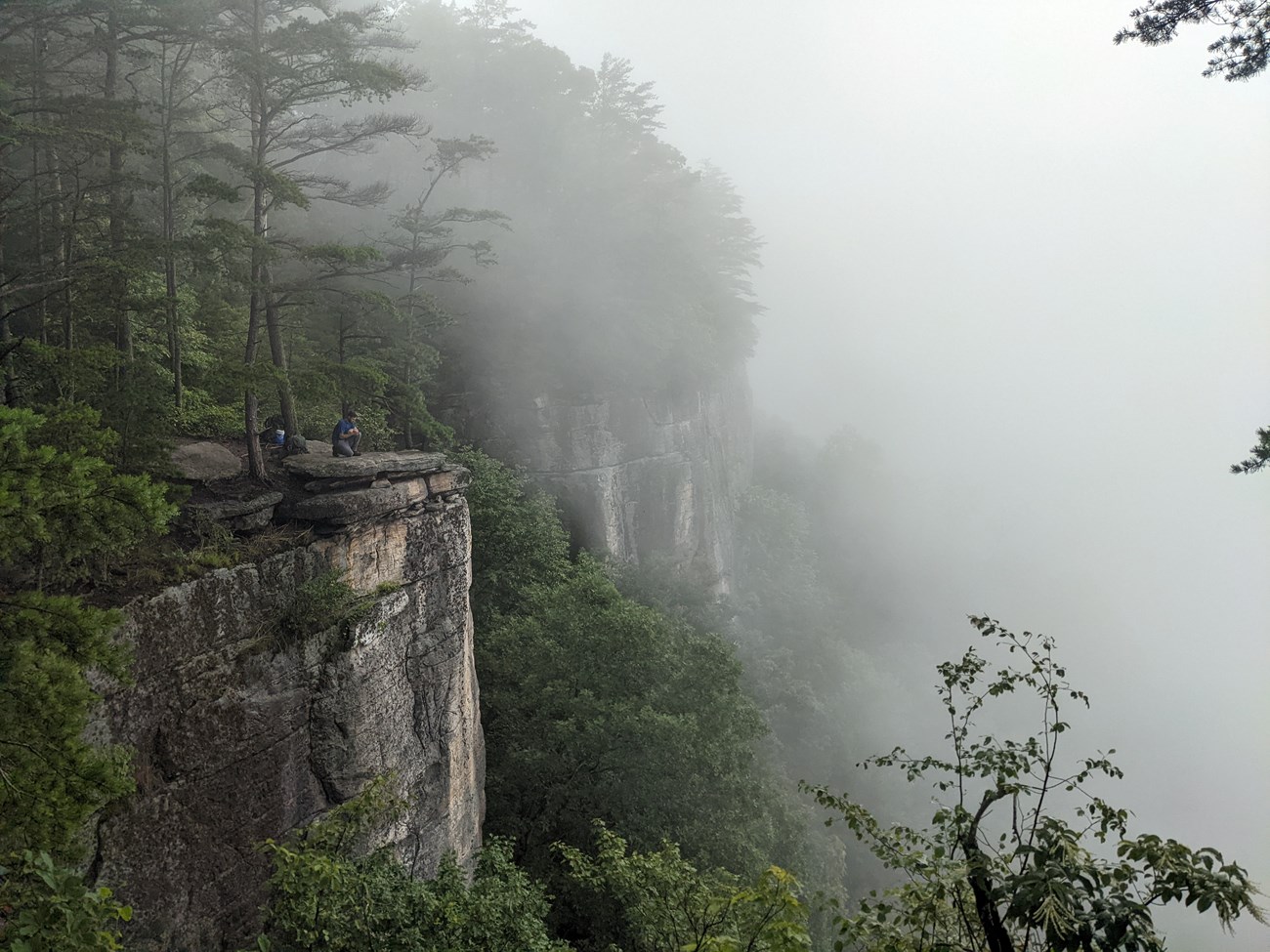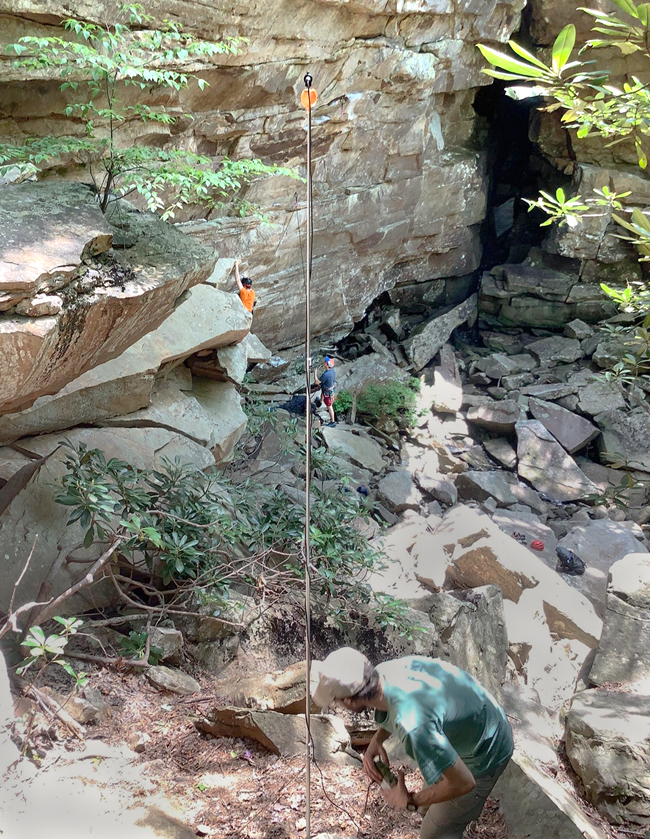Last updated: April 18, 2025
Article
Connection on the Cliffs: Scientists, Park Managers, and Climbers Partnering to Protect Bats
By Christina Martin, I&M Research Scientist and Communication Specialist
April 2025
At first glance, bats and rock climbers might seem like unlikely companions. But at New River Gorge National Park and Preserve, they’re drawn to the same dramatic landscape: towering cliffs riddled with cracks and ledges. For climbers, these features offer thrilling challenges. For bats, they are critical refuges for resting and hiding from predators.
With more than 1,600 established climbing routes reshaping cliffside environments, and several cliff-dwelling bat species in sharp decline, park managers began to wonder: could climbers be unintentionally harming bats?
When Habitat and Recreation Overlap
The park’s cliffs and forests are home to several vulnerable bat species, including the endangered northern long-eared bat (Myotis septentrionalis), Virginia big-eared bat (Corynorhinus townsendii virginianus), and Indiana bat (Myotis sodalis). Many bats in the park are already under immense pressure from white-nose syndrome, a deadly fungal disease that spreads during winter hibernation and has killed millions of bats across North America. These bats can’t afford additional stressors, so park managers wanted to know if visitors may be disturbing them.

© Copperhead Environmental Consulting
The park didn’t want to restrict recreation without clear evidence. So, in 2022, they partnered with the National Park Service’s Inventory & Monitoring Division and biologists from Copperhead Environmental Consulting to launch a study aimed at understanding how bats use cliffside habitats and whether climbers might be affecting them.
Scaling Cliffs for Science
Surveying cliffs for bats in New River Gorge was a massive undertaking. Biologists used two primary methods: rappelling down cliff faces to look for bats or signs of bat activity, and placing acoustic detectors at cliff bases to capture bat calls overnight. Each of the 51 survey sites, ranging from unclimbed to highly climbed, was visited three times to analyze how bat presence relates to human disturbance and habitat characteristics.

NPS / Copperhead Environmental Consulting
The rappelling team began early in the morning, hiking with their gear through thick vegetation to reach remote cliffs. They carefully inspected cracks and overhangs for bats and guano (poop) while listening for squeaking bats. They also noted cliff features like vegetation cover and crack sizes.

NPS / Copperhead Environmental Consulting
What They Found
Altogether, the team collected over 45,000 bat call recordings. Each bat species has a unique echolocation pattern, so researchers were able to identify several species using the cliffs. This included all three federally endangered bats and one state species of concern, the eastern small-footed bat (Myotis leibii).
Interestingly, despite the cliffs’ apparent suitability, researchers didn’t observe bats in the cliffs or find any guano. That was surprising—but it doesn’t mean bats aren’t using the cliffs. The reality is that the park has too many cliffs to survey them all thoroughly. That’s where climbers come in.
Climbers Step Up
One of the most exciting outcomes of the project was the enthusiastic response from the climbing community. As researchers worked in the field, climbers often stopped to ask questions, report bat sightings, or point out guano or crevices with animal activity.
These positive interactions led to a deeper partnership. New River Gorge joined the Climbers for Bat Conservation project, a national effort that encourages climbers to report bat encounters. The park also partnered with the New River Alliance of Climbers, a local group that has helped promote community involvement in the project. With so many climbing routes and only a limited number of scientists, climbers’ observations are becoming a vital tool for monitoring bats in the park and beyond.
The park hopes to build on this model of citizen science to study other cliff-dwelling species, like the green salamander. This kind of partnership could inspire similar efforts in other parks working to balance outdoor recreation with wildlife conservation.

NPS / Copperhead Environmental Consulting
Looking Ahead
Thanks to this study, park managers now have a clearer understanding of how bats use the cliffs—knowledge they can use to make informed decisions that support both wildlife and outdoor recreation. Continued research, climber engagement, and citizen science will be key to preserving these ecosystems.
Bats and climbers may move through the cliffs in different ways, but their future at New River Gorge is shared. Protecting it means working together.
Want to learn more?
Check out the final report from this project and, if you climb, explore how you can get involved in bat conservation!
Tags
- new river gorge national park & preserve
- inventory
- inventories
- inventory and assessment
- inventory and monitoring
- inventory and monitoring division
- new river gorge national park and preserve
- eastern rivers and mountains network
- natural resource stewardship and science
- bat conservation
- biodiversity
- science
- natural resource management
- collaborative conservation
- species inventory
